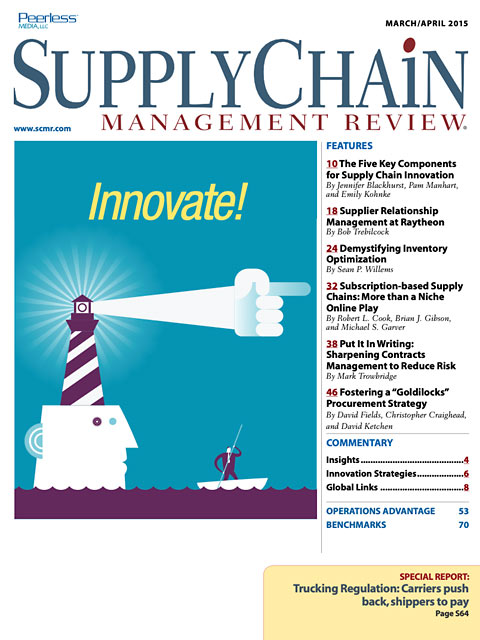Sorry, but your login has failed. Please recheck your login information and resubmit. If your subscription has expired, renew here.
March-April 2015
Anyone who’s ever bought a house knows the realtor’s motto: Location, location,location. It’s the most important factor in determining the value of a property. Based on the press releases that come across my desk these days, supply chain’s motto is: Innovate,innovate, innovate. This issue includes approaches to inventory optimization, contract management with third party logistics providers and contract manufacturers, and the Goldilocks approach to supply management—an innovative concept aimed at keeping your procurement department from running too hot or too cold. Browse this issue archive.Need Help? Contact customer service 847-559-7581 More options
Last summer I wrote a column titled “Holiday e-Commerce: Innovation Required” (SCMR Jul/Aug 2014). In it, I delved into the causes of the substantial late deliveries that occurred during the 2013 holiday season. Many gifts were not delivered in time to be put under the Christmas trees of lots of families. My view was that the e-retailers and parcel carriers set customer expectations too high. They positioned legacy services as if orders could be submitted as late as possible the day before, yet still be delivered by Christmas Eve. The media laid most of the blame on the parcel carriers despite the fact that retailers were equally—if not more—complicit. The carriers had not tailored their delivery services to accommodate holiday nuances, and retailers were characteristically struggling to handle large volumes of e-orders.
I concluded that parcel carriers and e-retailers needed to jointly innovate new holiday delivery services, especially more realistic delivery schedules. They appeared to have done this as delivery performance vastly improved this past holiday season. Apparently the parcel carriers added costly capacity and convinced retailers to not overpromise delivery dates, as well as to provide forecasts that they would not exceed. While deliveries improved, brick-and-mortar retailers still struggled because they retro-fitted existing supply chains, rather than making the investments needed to succeed in e-commerce.
Short History of Mass-Market Retail
I started my career at a consulting firm with Sears, and Roebuck and Co. as a client. Sears was the Wal-Mart of its day as the highest grossing merchandizer. Sears was also an early version of a successful omni-channel retailer with two major sales channels: brick-and-mortar stores and mail order catalogs (the precursor to e-commerce). Its legacy catalog business grew from the late 1880s by servicing the expanding Western frontiers. Sears separately managed two supply chains.
 |
This complete article is available to subscribers
only. Click on Log In Now at the top of this article for full access. Or, Start your PLUS+ subscription for instant access. |
SC
MR
Sorry, but your login has failed. Please recheck your login information and resubmit. If your subscription has expired, renew here.
March-April 2015
Anyone who’s ever bought a house knows the realtor’s motto: Location, location,location. It’s the most important factor in determining the value of a property. Based on the press releases that come across my… Browse this issue archive. Access your online digital edition. Download a PDF file of the March-April 2015 issue. |
Download Article PDF |
Last summer I wrote a column titled “Holiday e-Commerce: Innovation Required” (SCMR Jul/Aug 2014). In it, I delved into the causes of the substantial late deliveries that occurred during the 2013 holiday season. Many gifts were not delivered in time to be put under the Christmas trees of lots of families. My view was that the e-retailers and parcel carriers set customer expectations too high. They positioned legacy services as if orders could be submitted as late as possible the day before, yet still be delivered by Christmas Eve. The media laid most of the blame on the parcel carriers despite the fact that retailers were equally—if not more—complicit. The carriers had not tailored their delivery services to accommodate holiday nuances, and retailers were characteristically struggling to handle large volumes of e-orders.
I concluded that parcel carriers and e-retailers needed to jointly innovate new holiday delivery services, especially more realistic delivery schedules. They appeared to have done this as delivery performance vastly improved this past holiday season. Apparently the parcel carriers added costly capacity and convinced retailers to not overpromise delivery dates, as well as to provide forecasts that they would not exceed. While deliveries improved, brick-and-mortar retailers still struggled because they retro-fitted existing supply chains, rather than making the investments needed to succeed in e-commerce.
Short History of Mass-Market Retail
I started my career at a consulting firm with Sears, and Roebuck and Co. as a client. Sears was the Wal-Mart of its day as the highest grossing merchandizer. Sears was also an early version of a successful omni-channel retailer with two major sales channels: brick-and-mortar stores and mail order catalogs (the precursor to e-commerce). Its legacy catalog business grew from the late 1880s by servicing the expanding Western frontiers. Sears separately managed two supply chains.
 |
SUBSCRIBERS: Click here to download PDF of the full article. |
SC
MR

Latest Supply Chain News
Latest Podcast

 Explore
Explore
Latest Supply Chain News
- AdventHealth named top healthcare supply chain by Gartner
- Geopolitical readiness in supply chains: Strategic challenges for leaders
- Unlocking retention: The role employee engagement plays
- Can supply chain managers embrace an entrepreneurial mindset?
- Challenges to ESG reporting
- With capacity to spare, logistics real estate demand remains subdued
- More latest news
Latest Resources

Subscribe

Supply Chain Management Review delivers the best industry content.

Editors’ Picks





